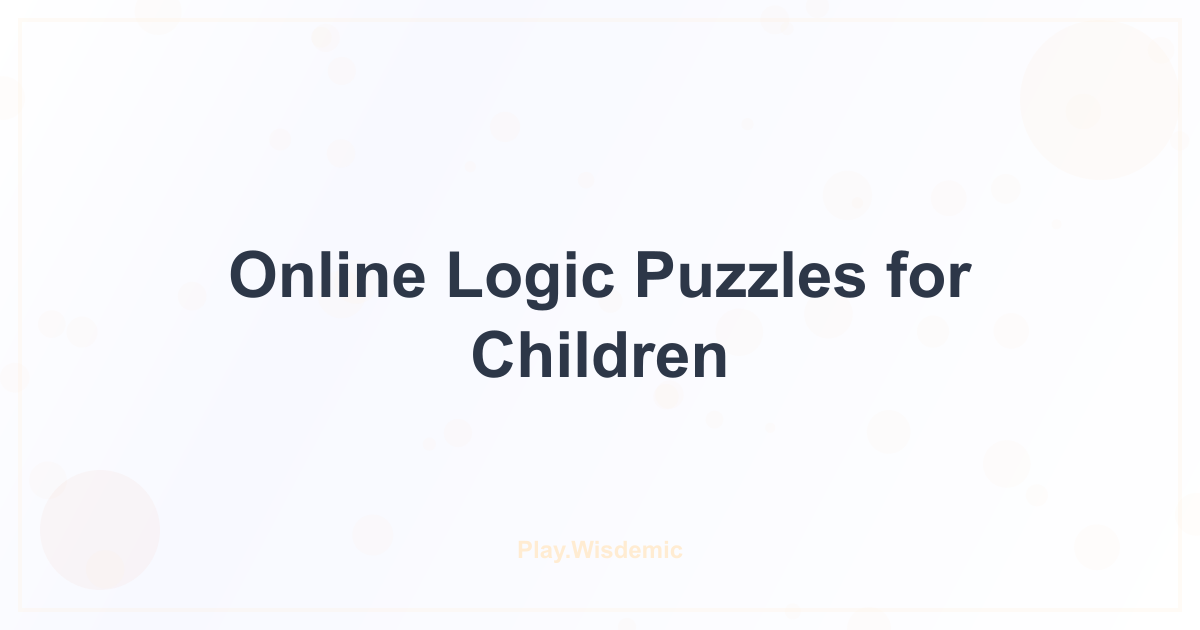Online logic puzzles represent the perfect marriage of technology and traditional brain training. Unlike physical puzzles that can get lost under couch cushions, digital versions offer infinite variety, instant feedback, and adaptive difficulty—all without the cleanup. However, navigating the crowded landscape of online puzzle platforms requires a discerning parent's eye. Between intrusive ads, age-inappropriate content, and overly complex interfaces, finding truly child-friendly logic puzzles can feel like solving a puzzle itself. Here's your comprehensive guide to selecting, using, and maximizing online logic puzzles for developing minds.
Why Digital Logic Puzzles Excel
While traditional puzzles have their place, online versions offer unique advantages that can accelerate logical thinking development:
- Instant Feedback: Children receive immediate confirmation of correct moves, reinforcing successful strategies.
- Adaptive Difficulty: Smart algorithms adjust challenge levels based on performance, preventing boredom or frustration.
- Unlimited Variety: Thousands of puzzles at your fingertips, with new challenges generated automatically.
- Progress Tracking: Visual indicators show skill development over time, motivating continued play.
- Interactive Elements: Animations, sounds, and visual effects enhance engagement without distracting from learning.
- Accessibility Features: Adjustable text size, color contrast, and audio cues accommodate different learning needs.
Essential Types of Online Logic Puzzles
1. Sequence & Pattern Puzzles
These foundational puzzles build the pattern recognition skills essential for mathematics and reading:
- Color Sequences: Complete patterns like red-blue-red-blue-?
- Shape Progressions: Identify the next shape in geometric sequences
- Number Patterns: Discover rules governing numerical sequences (2, 4, 6, 8...)
- Size Gradations: Arrange objects from smallest to largest or continue size patterns
2. Spatial Reasoning Challenges
- Maze Navigation: Plan routes through increasingly complex pathways
- Block Puzzles: Fit pieces together to complete shapes or pictures
- Rotation Games: Predict how objects look when turned or flipped
- 3D Visualization: Understand how 2D patterns translate to 3D objects
3. Deductive Reasoning Games
- Grid Logic: Use clues to determine correct placement of objects
- Process of Elimination: Rule out impossible options to find solutions
- If-Then Scenarios: Apply conditional logic to solve multi-step problems
- Category Sorting: Group items based on shared characteristics
4. Mathematical Logic
- Number Bonds: Find combinations that add up to target numbers
- Balance Puzzles: Determine weights needed to balance scales
- Logic Grids: Use mathematical relationships to fill in missing numbers
- Probability Games: Make predictions based on likelihood
Parent's Safety & Selection Checklist
Not all online puzzle platforms prioritize child safety and educational value. Use this checklist to evaluate potential options:
Safety Considerations
- Ad-Free Environment: Avoid platforms with pop-up ads or external links that children might accidentally click
- Privacy Protection: Choose sites that don't collect personal information or require extensive registration
- Age-Appropriate Content: Verify that all puzzles and themes are suitable for your child's developmental stage
- Secure Connections: Look for HTTPS encryption and legitimate privacy policies
Educational Quality Markers
- Clear Learning Objectives: Each puzzle type should target specific cognitive skills
- Graduated Difficulty: Puzzles should progress logically from simple to complex
- Multiple Solution Paths: Good puzzles allow creative approaches rather than single “correct” methods
- Meaningful Feedback: Responses should guide learning, not just indicate right/wrong
How Play.Wisdemic Addresses Common Concerns
We designed our platform specifically to address the shortcomings parents encounter with other online puzzle sites:
- Zero Advertisements: No pop-ups, banners, or external links to distract or concern parents
- Adaptive Intelligence: Our AI monitors solving patterns and adjusts difficulty in real-time
- Parent Dashboard: Track progress, set time limits, and understand your child's strengths
- Multiple Puzzle Types: From pattern sequences to spatial reasoning, all in one safe environment
- Offline Capability: Download puzzles for car trips or areas with limited internet
Maximizing Learning Through Strategic Play
Getting Started Right
Your child's first experience with online logic puzzles sets the tone for future engagement. Sit beside them for initial sessions, modeling problem-solving strategies aloud: “I notice this pattern repeats every three shapes. Let me see what comes next...” This thinking-aloud technique helps children internalize effective reasoning processes.
Building Persistence
Logic puzzles naturally involve trial and error, which can frustrate children accustomed to immediate success. Celebrate the thinking process rather than just correct answers: “I love how you tried a different approach when the first one didn't work!” This builds resilience and growth mindset.
Connecting to Real Life
Help children recognize logic puzzle skills in everyday situations. After working on pattern puzzles, point out patterns in nature, music, or daily routines. This transfer strengthens learning and shows practical relevance.
A Real Success Story
Last month, my daughter struggled with a particularly challenging sequence puzzle on Play.Wisdemic. Instead of giving up, she started drawing the pattern on paper to better visualize the relationships. Not only did she solve the digital puzzle, but she also created her own pattern challenges for the family. That offline extension showed deep understanding and creative application—exactly what quality logic puzzles should inspire.
FAQ
How much time should children spend on logic puzzles daily?
Start with 10-15 minute sessions and adjust based on your child's attention span and interest. Quality engagement matters more than duration.
What if my child finds online puzzles too easy or too hard?
Look for platforms with adaptive difficulty like Play.Wisdemic, which automatically adjusts challenge levels. You can also manually select different difficulty tiers.
Are online logic puzzles better than physical ones?
Both have unique benefits. Digital puzzles offer variety and instant feedback, while physical puzzles provide tactile experience. A combination works best.
How can I tell if the puzzles are actually educational?
Quality educational puzzles target specific cognitive skills (pattern recognition, spatial reasoning, deductive logic) and provide clear progression paths. Avoid purely entertainment-focused games.
What about screen time concerns?
Logic puzzles represent active, educational screen time rather than passive consumption. Set clear boundaries and balance with offline activities.
Ready to explore safe, educational logic puzzles? Try Play.Wisdemic's ad-free environment and watch your child's reasoning skills flourish through purposeful digital play!
